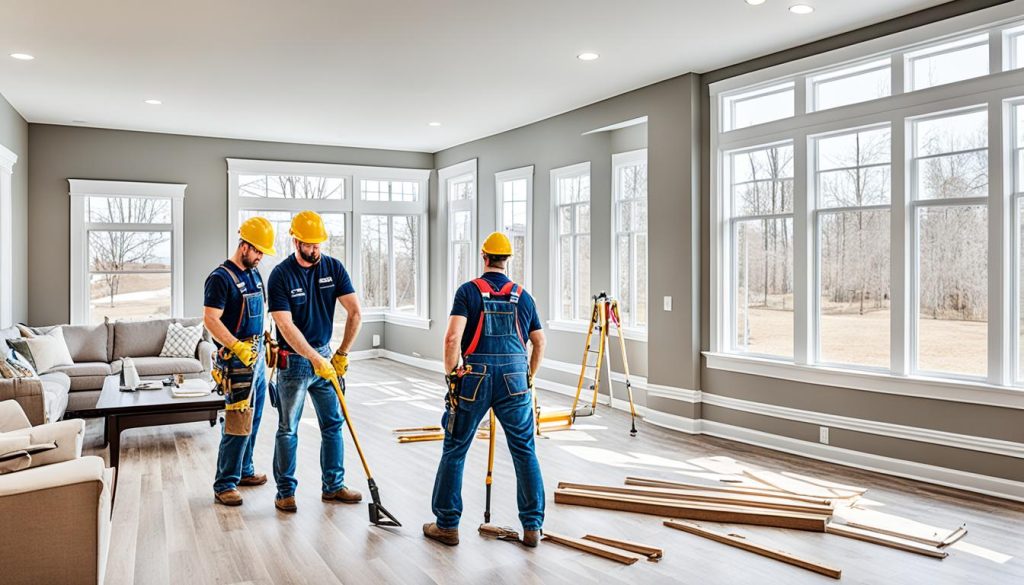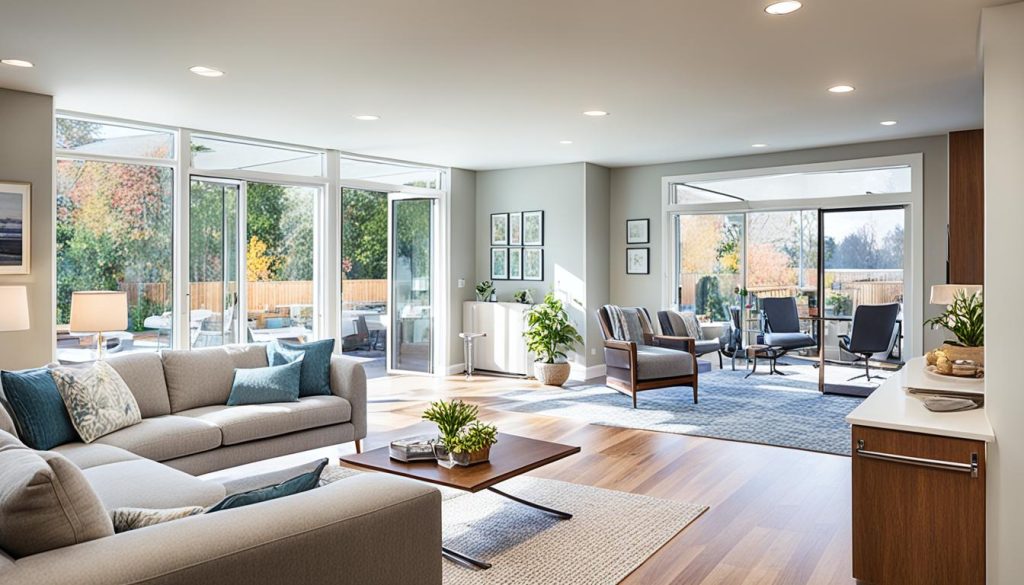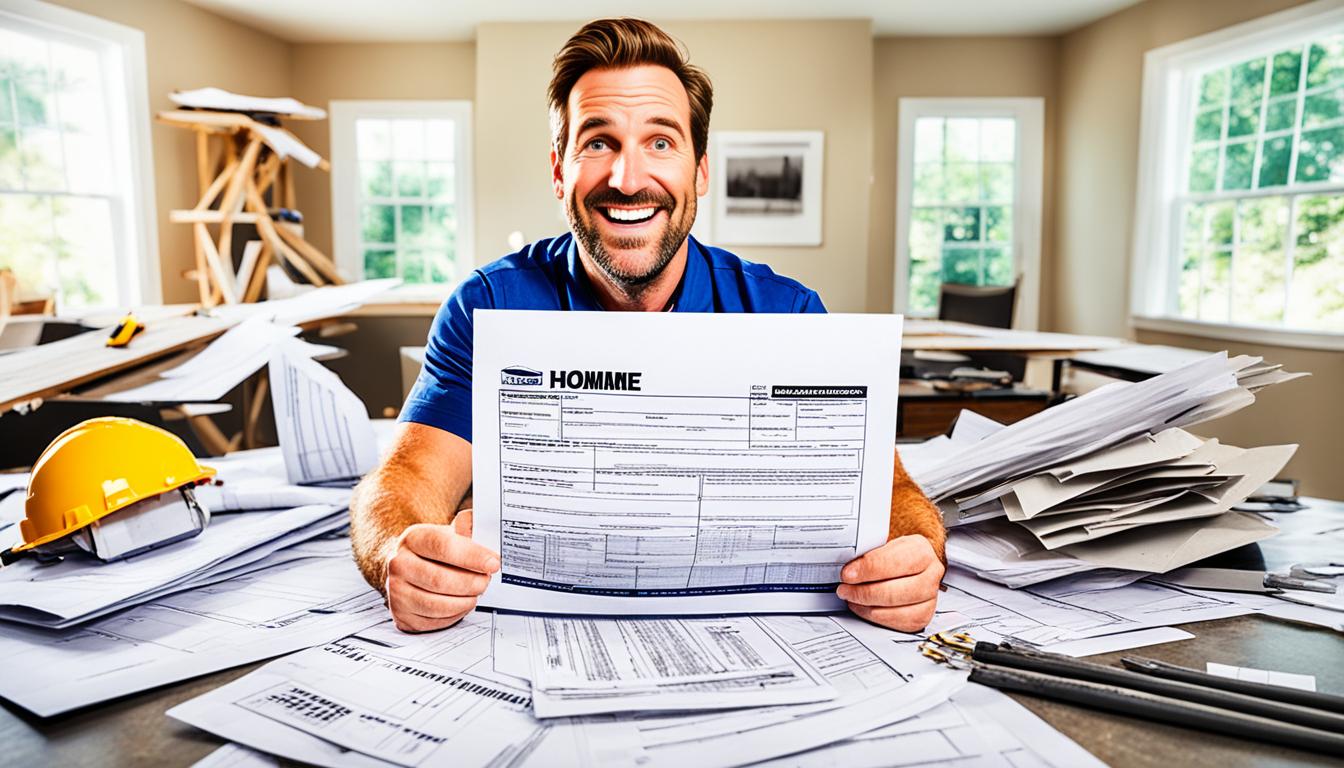Are you aware that certain home renovations can actually help you save on your taxes in Canada? It’s true! The Canadian government offers tax deductions and credits for eligible home improvements, making renovations more affordable for homeowners. Whether you’re considering a kitchen upgrade, a bathroom remodel, or energy-efficient retrofits, understanding the tax benefits can make a significant difference in your renovation plans.
Let’s dive into the various tax deductions and credits available in Canada for home renovations, so you can make the most of your renovation projects and potentially save money in the process.
Key Takeaways:
- Certain home renovations in Canada may be eligible for tax deductions and credits.
- The Canada Greener Homes Initiative provides grants and tax credits for eligible retrofits.
- Provincial home renovation tax credits are available in several provinces across Canada.
- The Home Accessibility Tax Credit and Multigenerational Home Renovation Tax Credit offer additional federal tax benefits for specific renovations.
- Eligible expenses for home renovation tax credits include functional improvements and accessibility modifications.
Canada Greener Homes Initiative
The Canada Greener Homes Initiative is an initiative by the Canadian government aimed at promoting energy-efficient and sustainable living through home improvement retrofits. Under this initiative, homeowners can avail of grants and loans for conducting home evaluations and implementing eligible retrofits. These retrofits not only contribute to reducing energy consumption but also qualify for tax credits, making them a more affordable option for homeowners.
The eligible retrofits under the Canada Greener Homes Initiative include:
- Space and water heating upgrades
- Home insulation improvements
- Air-sealing
- Window and door replacements
- Installation of thermostats and renewable energy systems
- Implementing resiliency measures to protect the home from environmental damages
These retrofits play a crucial role in making homes more energy-efficient, reducing greenhouse gas emissions, and promoting sustainable living. By opting for these eligible retrofits, homeowners not only contribute to a greener environment but also benefit from tax credits, which can help offset the overall cost of their home renovations.
| Retrofit | Tax Credit Eligibility |
|---|---|
| Space and water heating upgrades | Yes |
| Home insulation improvements | Yes |
| Air-sealing | Yes |
| Window and door replacements | Yes |
| Thermostat and renewable energy systems installation | Yes |
| Resiliency measures | Yes |
Provincial Home Renovation Tax Credits
Did you know that several provinces in Canada offer their own home renovation tax credits? These credits provide homeowners with additional savings and incentives for eligible home renovations. However, it’s important to note that each province may have different eligibility criteria and specific details for claiming these tax credits. If you’re considering a home renovation project, make sure to check the appropriate government websites for more information on the provincial home renovation tax credits available in your area.
Here are some provinces that offer home renovation tax credits:
- British Columbia
- Saskatchewan
- Manitoba
- Ontario
- Quebec
- New Brunswick
By taking advantage of these provincial tax credits, you can reduce the overall cost of your home renovations and make your dream home a reality.

British Columbia Home Renovation Tax Credit
In British Columbia, homeowners may be eligible for the BC Home Renovation Tax Credit. This credit is specifically designed for seniors and persons with disabilities, providing them with financial assistance for renovations that improve accessibility and safety within their homes.
Saskatchewan Home Renovation Tax Credit
Saskatchewan offers the Saskatchewan Home Renovation Tax Credit, which allows homeowners to claim a non-refundable tax credit for eligible home renovation expenses. The credit can help offset the costs of home improvements and encourage homeowners to invest in their properties.
Ontario Seniors’ Home Safety Tax Credit
In Ontario, seniors can take advantage of the Ontario Seniors’ Home Safety Tax Credit. This credit aims to help seniors make their homes safer and more accessible by providing financial assistance for eligible home renovation expenses.
New Brunswick Seniors’ Home Renovation Tax Credit
New Brunswick offers the Seniors’ Home Renovation Tax Credit, which is available to seniors aged 65 and older. This tax credit provides financial assistance for home renovations that improve accessibility, safety, and energy efficiency.
Quebec Home Renovation Tax Credits
Quebec has several home renovation tax credits available, including the RénoVert tax credit and the LogiRénov tax credit. These credits provide homeowners with financial incentives to undertake eco-friendly home renovations and improvements.
Remember to verify the eligibility criteria and specific requirements for each provincial tax credit you wish to claim. By taking advantage of these programs, you can make your home renovations more affordable and enjoy the benefits of an upgraded living space.
| Province | Tax Credit |
|---|---|
| British Columbia | BC Home Renovation Tax Credit |
| Saskatchewan | Saskatchewan Home Renovation Tax Credit |
| Ontario | Ontario Seniors’ Home Safety Tax Credit |
| New Brunswick | New Brunswick Seniors’ Home Renovation Tax Credit |
| Quebec | RénoVert Tax Credit |
| Quebec | LogiRénov Tax Credit |
Federal Home Accessibility Tax Credit
If you’re a homeowner looking to make your home more accessible for seniors or persons with disabilities, the Federal Home Accessibility Tax Credit can provide financial assistance. This tax credit is offered by the federal government and allows eligible individuals to claim a percentage of their expenses for accessibility renovations as a credit towards their income tax owed.
To qualify for the Home Accessibility Tax Credit, the renovations must improve mobility within the home and reduce the risk of harm. This can include modifications such as installing wheelchair ramps, widening doorways, adding grab bars, and implementing non-slip flooring.
It’s important to note that the Home Accessibility Tax Credit is non-refundable, meaning it can only be used to reduce the amount of income tax owed. However, if you’re unable to claim the full amount in one year due to insufficient income tax payable, the credit can be carried forward to future years.
When claiming the Home Accessibility Tax Credit, make sure to keep all relevant receipts and documentation as proof of your eligible expenses. This includes invoices, contracts, and proof of payment for materials and labor.
To learn more about the eligibility requirements and how to claim the Home Accessibility Tax Credit, visit the official website of the Canada Revenue Agency (CRA) or consult with a tax professional for guidance.
Home Accessibility Tax Credit at a Glance:
- Tax credit offered by the federal government
- Aims to increase accessibility for seniors or persons with disabilities
- Eligible expenses include renovations that improve mobility and reduce the risk of harm
- Non-refundable tax credit
- Percentage of eligible expenses can be claimed as a credit towards income tax owed
- Keep receipts and documentation as proof of eligible expenses

Multigenerational Home Renovation Tax Credit
If you’re considering adding a secondary unit to your home to accommodate immediate or extended family members, you may be eligible for the Multigenerational Home Renovation Tax Credit. This federal tax credit, introduced in the 2022 budget, aims to support multigenerational living arrangements by providing financial incentives for renovations.
The Multigenerational Home Renovation Tax Credit is a non-refundable credit that can help offset the costs of eligible expenses for the renovation. To qualify, the renovation must involve the addition of a secondary unit to your existing home, such as a basement suite or a separate dwelling within the property, specifically designed for the use of immediate or extended family members.
To claim this tax credit, it’s important to keep detailed records of your renovation expenses, including invoices, contracts, and proof of payment. You’ll need to provide these documents when filing your federal income tax return to demonstrate the eligibility and cost of your renovation.
By taking advantage of the Multigenerational Home Renovation Tax Credit, you can make your home more accommodating for your loved ones while potentially benefiting from a federal tax credit. It’s always recommended to consult with a tax professional or visit the official government website for further information and guidance on claiming this credit.
| Eligible Expenses | Non-Eligible Expenses |
|---|---|
| Construction costs related to adding a secondary unit | Furniture or appliances for the secondary unit |
| Permit and inspection fees | Landscaping or exterior improvements unrelated to the secondary unit |
| Architectural and design fees | Repair or maintenance costs unrelated to the secondary unit |
Provincial Home Renovation Tax Credits (Continued)
In addition to the federal tax credits, several provinces in Canada offer their own home renovation tax credits. These provincial programs provide additional incentives and savings for homeowners undertaking eligible renovations. Let’s explore some of the provincial tax credits available:
1. BC Home Renovation Tax Credit
The BC Home Renovation Tax Credit is designed to support seniors and persons with disabilities in British Columbia. Eligible individuals can receive a non-refundable tax credit for renovations that improve accessibility and assist with independent living. The credit is calculated as a percentage of eligible expenses, providing financial relief to those making necessary home modifications.
2. Saskatchewan Home Renovation Tax Credit
Saskatchewan offers a Home Renovation Tax Credit to residents who complete eligible renovations on their primary residence. This tax credit allows homeowners to claim a portion of their renovation expenses, encouraging improvements that enhance energy efficiency, accessibility, and comfort.
3. Ontario Seniors’ Home Safety Tax Credit
The Ontario Seniors’ Home Safety Tax Credit is available to help seniors make their homes safer and more accessible. Eligible individuals can claim a refundable tax credit based on the expenses incurred for specific renovations, such as installing grab bars, stairlifts, or walk-in bathtubs. This tax credit aims to support aging residents in maintaining their independence and well-being.
4. New Brunswick Seniors’ Home Renovation Tax Credit
New Brunswick offers a Seniors’ Home Renovation Tax Credit to assist seniors with the costs of home renovations that promote accessibility and aging in place. This refundable tax credit provides financial relief by allowing eligible individuals to claim a portion of their renovation expenses on their tax return.
The specific eligibility criteria, qualifying expenses, and application procedures for these provincial tax credits may vary. It’s important to consult the respective provincial government websites or contact professional tax advisors for accurate and up-to-date information.
| Provincial Tax Credit | Eligibility Criteria | Qualifying Expenses |
|---|---|---|
| BC Home Renovation Tax Credit | Seniors and persons with disabilities in British Columbia | Renovations improving accessibility and independent living |
| Saskatchewan Home Renovation Tax Credit | Residents completing renovations on their primary residence in Saskatchewan | Renovations enhancing energy efficiency, accessibility, and comfort |
| Ontario Seniors’ Home Safety Tax Credit | Seniors in Ontario | Renovations promoting home safety and accessibility |
| New Brunswick Seniors’ Home Renovation Tax Credit | Seniors in New Brunswick | Renovations supporting accessibility and aging in place |
Eligible Expenses for Home Renovation Tax Credits
To qualify for home renovation tax credits, the renovations must meet certain criteria. Eligible expenses typically include functional improvements and accessibility modifications that improve mobility and reduce the risk of harm. Examples of eligible expenses can include:
- Wheelchair ramps
- Widened doors
- Grab bars
- Non-slip flooring
- Automated switches
These expenses can make a significant difference in the accessibility and safety of your home. By making these improvements, you not only qualify for tax credits but also create a more comfortable living space that caters to your specific needs.
When planning your renovations, it’s important to review the specific criteria for each tax credit to ensure that the renovations meet the eligibility requirements. Some tax credits may have additional requirements, such as maximum expense limits or certified contractors. By familiarizing yourself with the rules and regulations, you can make informed decisions and maximize the benefits of the home renovation tax credits.
Maximizing Tax Benefits for Home Renovations
When it comes to home renovations, maximizing tax benefits can help offset the costs and make your improvements more affordable. To make the most of these benefits, it’s crucial to claim eligible expenses and keep detailed receipts and documentation.
Start by keeping track of all invoices, contracts, and proof of payment for materials and labor. These receipts will serve as evidence of your eligible expenses and ensure that you receive the maximum tax benefits available. By accurately documenting your costs, you can confidently claim deductions or credits for your home renovations.
Consulting with a tax professional can also be beneficial. They have expertise in navigating the complexities of tax deductions and credits for home improvements. They can provide guidance on the specific eligibility requirements and help you understand which expenses can be claimed to maximize your tax benefits.
Remember, by staying organized and providing the necessary documentation, you can confidently claim eligible expenses and maximize the tax benefits for your home renovations.

Leave a Reply
You must be logged in to post a comment.